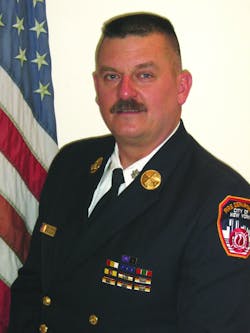The stairs and stairways that allow people to ascend and descend to their apartments, offices, shopping centers and many other occupancies are constructed and designed in numerous shapes, sizes and formats. As firefighters, we routinely use the same stairways to access these areas, transport injured people, carry our equipment and stretch hoselines. So what kind of stairs might we encounter and how can we use that knowledge to help us perform our work safer and faster?
Stairway types and features
Some stairs simply run up to the next level in a straight line. It’s a pretty simple design and usually quite easy to ascend and descend. That is even true for transporting a victim in a Stokes basket, on a backboard or in a stair chair. Carrying tools—meaning fire tools, like 6-, 8- and 10-foot hooks—is not much of a problem, and firefighters can even carry a portable ladder up one of these stairways fairly easily.
When stretching a hoseline up a straight run stairway, take note of where the fire is on the floor above if possible. If the fire is visible out the front windows on the second floor and the stairs are straight run, you may need to pull more hose into the building to reach the seat of the fire.
Straight run stairs often run from the front, just inside the entrance door, and ascend toward the rear. When you reach the second floor, you may very well be at the back or further back in the building, which will require you to then stretch the distance back toward the front where you saw the fire venting as you entered.
One variation of these stairs is when the stairs reach the second floor, after the landing, they continue in the same direction, toward the rear and leave the person at the next floor landing even further back toward the rear of the building.
Another feature of the straight stairway exists in multi-story buildings. The stairway is a straight run stair, but when you reach the second floor, the climb is over and you must make a 180-degree turn, walk back toward the front of the building and make another 180-degree turn and begin climbing the stairs to the next level. The stairs to the third floor are positioned directly over the stairs to the second floor, and that design continues to the top floor. These stairs present few challenges for firefighters carrying equipment or patients, as long as the stairs are not too narrow. For those of us who work in communities with old buildings (very old), narrow hallways and stairways are often the rule.
These multi-story straight run stairs may be positioned quite close to the landings they serve or they may have constructed a “well hole” next to the stairway. A well hole exists if you can climb the stairway to the second floor, and when you reach the top and make that first 180-degree turn, you can look down between the hallway bannister and the stairway bannister. The well hole would be an open space between the bannisters that would allow you to drop a basketball through it and it would fall to the first floor. Some well holes are even larger and can be several feet wide. This feature makes stretching a hoseline up that stairway quite easy and very quick.
The first firefighter or officer to enter that building needs to look for and note if there is a well hole, and that info needs to be immediately transmitted via portable radio to the engine crew out in the street. The well hole makes for a rapid and easy stretch, but it can also reduce the number of lengths required as well. A standard stairway stretch to the fifth floor could require six lengths of hose; the same stairway with a well hole may only require three lengths! Additionally, a well hole allows firefighters to hoist equipment up and down that shaft rather than carrying that material up and down the stairs. Note: When stretching a hoseline up a stairway with a well hole, the line must be secured with hose straps to the bannister or newel post so it does not pull and slide down, against the efforts of the engine crew attacking the fire.
In sum
As you can see there is a lot to know about stairs and stairways that firefighters can learn to help us perform our duties in the numerous buildings where we are called to work. Don't wait for a call to find out about the stairways in your buildings. Get out there and discover what types of stairways you may be working in at your next fire.

John J. Salka Jr. | Battalion Chief
JOHN J. SALKA JR., who is a Firehouse contributing editor, retired as a battalion chief with FDNY, serving as commander of the 18th battalion in the Bronx. Salka has instructed at several FDNY training programs, including the department’s Probationary Firefighters School, Captains Management Program and Battalion Chiefs Command Course. He conducts training programs at national and local conferences and has been recognized for his firefighter survival course, “Get Out Alive.” Salka co-authored the FDNY Engine Company Operations manual and wrote the book "First In, Last Out–Leadership Lessons From the New York Fire Department." He also operates Fire Command Training, which is a New York-based fire service training and consulting firm.






